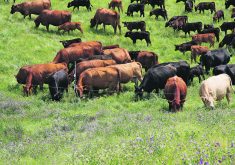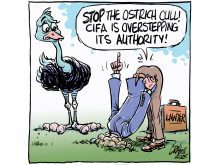Morally bankrupt
Re: Medical, justice systems failed Latimers (WP, Dec. 20).
Did society (medical and justice systems) fail the Latimers, as Mr. Brown so emphatically claims?
No, Mr. Latimer failed the Latimers, especially his daughter who, in case we forget, he killed and that’s why he’s in jail.Â
Do conscientious, loving parents kill their children? Now that’s an ethical dilemma that Mr. Brown could do well to do some more study on before he weighs in with his ill-formed ideas.
Read Also

Budget seen as fairly solid, but worrying cracks appear
The reaction from the agriculture industry to prime minister Mark Carney’s first budget handed down November 4th has been largely positive.
Once again, we are left with the Kevorkian/Morgentaler mindset that says we have the right to play God. Last I heard, only God gets to be God.
Pray that we don’t have more Rob Browns dictating social policy because his is truly a bankrupt moral economy.
– Ron Wall,
Calgary, Alta.
Price check
I don’t know exactly how to express this because I find it is so upsetting and disturbing to hear a farmer or rancher complain that barley prices are too high.
I am referring to an article in the Dec. 8 edition of The News Review, a Yorkton paper where a cattleman is complaining that the price of barley is too high.
I hope he didn’t mean it like it sounds. If so, I would like to know where he buys his oil, gas, diesel, fertilizers, weed chemicals and so on at such low prices that he thinks barley prices are too high, causing cattle prices to be too low.
In my humble opinion, the blame should be placed where it belongs, on the high cost of inputs and the increase in the value of the Canadian dollar. This is what is killing the agriculture industry. We are an exporting country, thus the high dollar is hurting manufacturing as well.
As for high grain prices, I don’t know where anyone gets that notion from. Yes, they are higher grain prices, but high grain prices compared to what? Twenty-five years ago grain prices were this high and inputs were a quarter of what they are now and even at today’s prices for wheat, it takes three to four times the amount of wheat to buy a tractor or combine than it did 25 years ago. So please get real when you talk about high grain prices….
An article in the Dec. 13 issue of The Western Producer states that biofuel is not causing the price of food to rise. It also states that a 30 percent rise in the price of grain only increases the price of food by 1.1 percent.
Please put the blame for your loss of income where it belongs, not on the shoulders of your neighbour.
– Ken Leftwich,
Esterhazy, Sask.
Freedom & risk
Mr. Cushon in his letter Dec. 20 says that since I do not know the prices which the Canadian Wheat Board gets in all markets that I am “perhaps misjudging the CWB’s performance.”
He is right. I do not know all the prices the CWB gets in all markets. Does he? Perhaps I am misjudging the CWB. Perhaps he is. Perhaps their performance is worse than I suggest.
The point is that if I were free to sell my wheat to whomever I wished at whatever price I wished I would have no one to complain about for the result except myself.
I might receive more. I might receive less. In either result I would have been able to do what I thought was, for myself, the best thing. That is called risk-taking. It is called freedom.
I recognize that not all producers want to take the risks of marketing. No one could complain about voluntary pooling. That was how the wheat pools began on the Prairies – on a voluntary basis.
Those who want to pool their production with others should be free to do so. But so too should those of us who wish to take marketing risks be free to do so.
What causes someone to argue against freedom? Is it fear? Is it envy? I am interested to know Mr. Cushon’s reason.
Data on the weighted price obtained by U.S. farmers will be available in February. We will see what it tells us.
However, the issue is not whether I can time the market better than can the CWB. I may not always be able to get a higher price than the CWB can, or than my neighbour can. The issue is whether the CWB should be selling my wheat or barley at all.
The price I get when I want to get it, to meet my individual requirements, may not always be the highest price but is surely the “best” price….
High price or low price, the best price is the one I get for myself.
– David Schnell,
Kenosee Lake, Sask.
Ritz audacity
Gerry Ritz has the audacity to claim that his government communicates honestly with farmers? (WP, Dec. 20.)
One of the oldest adages in the English language is “you can’t have your cake and eat it too,” yet this is just what their dishonest federal government offered as an option in the barley plebiscite.
Even the language of the ballot was dishonest. It was “shall it be A” or “shall it be B” or would you “like” it to be both A and B.
The best agricultural economists on the Prairies have told us that the CWB nets us an extra $10 per tonne for our grain and does so because it is a monopoly seller.
The CWB marketers are good but if they could make $400 million per year, not by its power of a monopoly but by marketing genius alone, they would be on the 100th floor of some American office building putting Warren Buffet on hold.
Mr. Ritz tries to deflect criticism of his party’s manipulation by claiming that the opposition parties insult farmers by saying that they are not competent enough to understand the plebiscite question.
I know a great many farmers, some brilliant and some dopey, but the factor that caused so many to vote for the impossible option is not stupidity.
It is rather a combination of politics, loyalty, willful ignorance, desperation, apathy and a literal interpretation of the question, irrespective of the reality of the situation….
An honest barley plebiscite would have returned about four to one in favour of the CWB. It would have been uncontroversial, boring and had the same options as my kids get for supper: take it or leave it.
– Glenn Tait,
Meota, Sask.
Cattle showing
This is in response to the letter in the Dec 6 issue by Margaret Leigh. As a purebred cattle producer, I do show at (Canadian Western) Agribition and I do the so called primp of my cattle.Â
It behooves all cattle producers, regardless of whether they are commercial or purebred, to resist denigrating one of our peers.Â
Maybe the show routine isn’t for her. But that does not make the cattle showed at Agribition poor animals, and maybe they won’t fit into her operation, but they may fit into some one else’s.Â
I know my own cattle are raised just the same as their commercial counterparts in my own herd. They may be born a little earlier and go on feed a little earlier but they are basically raised the same.
Yes, every cow should produce a calf every year, but how long is your breeding season that you expect a bull to produce 40 calves naturally every year?
Some bulls can, in a 45 to 60 day breeding season, but most experts and vets will tell you the optimal amount of cows to bulls is 25 or 30 cows to one bull.Â
As for the $20 supplemental feed issue, she obviously doesn’t know the cost of a bag of minerals.Â
At $25 or more for a bag of minerals, one cow needs per year about one and a half bags … as well as a host of other things all necessary to the good health of our cattle.Â
Gone are the days when you turn your cattle out after selling your calves and bring them back in at branding time and count how many you have left.Â
Besides the welfare issue, there is the issue of optimizing your genetics to get optimum returns and how best to do that is left up to each individual producer.
What works for one doesn’t work for the other so please don’t put down one very important sector of the beef industry just because it’s something you don’t understand or care to do.
– Sandra Jeffery,
Moose Jaw, Sask.
Raised dead
Prime Minister Steven Harper’s mentor, Brian Mulroney, once famously said that he would only appoint a non-conservative to a patronage appointment when there was not a living breathing Conservative left.
Harper has gone one better.
He has raised the political dead by appointing Reform party operative Elwin Hermanson to the critical position of Chief Commissioner of the Canadian Grain Commission.Â
This zombie out of the danker areas of Saskatchewan’s political landscape is a noted hater of all things government and anything that supports farmers in particular.Â
Mr. Hermanson’s love of the corporate sector can now be given free rein in his new job of policing and regulating the international grain trade in Canada to protect farmers and our reputation for delivering identity preserved, high quality grain.Â
This is further evidence of the Harper government doing its best to destroy the integrity of Canadian institutions by putting partisans into previously neutral positions of authority. Â
– Ken Larsen,
Benalto, Alta.
Food advice
In response to two recent articles. First the 100-mile diet.
Has Ed White (Editorial Notebook, Dec. 6) never heard of canning, freezing, etc. the produce when it is in season to use when it isn’t? How does he think our ancestors managed to survive? Has he never read any real pioneer stories?
If then settlers arrived in an area too late in the season to plant a garden, they looked for berries to dry or preserve to use over the winter.
Early in the spring they ate fresh dandelions and lambs quarters, certainly not asparagus. Unless you’ve never tasted wild raspberries or wild strawberries, you are not from a rural area and don’t know what you are missing.
My ancestors got their Vitamin C in winter by eating rose hips.
My grandmother squeezed carrot juice into her homemade butter in winter to give it colour and beta-carotene, no doubt learning this from her ancestors in Poland.
How many city people know that fresh cream in winter is nearly white due to the cows’ change in diet and or lack of sunlight?
Our ancestors survived on a diet from a lot closer to home than 100 miles.
The second point is about eating meat (Open Forum, Nov. 29.) What did the First Nations people live on mainly before white people came along?
Wild game of all kinds, all chemical free. They also ate wild plants (and) berries too but again it was all chemical free and guess what? No obesity, diabetes, heart disease, cancer until they started eating white man food and white men brought small pox, tuberculosis and a myriad of other diseases from Europe. …
If people used raw dairy products instead of these over-processed products that have a shelf life that’s beyond common sense, they would be a lot healthier.
My mother’s cats will not drink milk unless it’s in a can. They are smarter than people.
Avoid all soy products and MSG and drink distilled water plus put a filter on your water supply or shower to avoid chlorine.
– Elaine Sloan,
Busby, Alta.
CFIA role
Re: Beef promotion not proper role of CFIA (WP editorial, Dec. 6). Firstly I would say this looks like a release from the Canadian Food Inspection Agency looking for support in its mandate to continue the drastic agenda of food safety regulations …
Having worked for Agriculture Canada Health of Animals Branch, in both animal health and meat hygiene, I beg to differ with your interpretation of inspectors being in conflict with promotional rather than factual if they promote Canadian product.
Specified risk material removal and burial: Having worked on brucellosis, tuberculosis, Johnes, rabies programs for many years, these programs used science, not political science, in eliminating these diseases from our cow herds with minimal disruption to the beef industry.
I must say these diseases were contagious to man and more capable of infecting the human population than BSE. As I understand it, the kill plants are located in Western Ontario and the only approved landfill site (for SRM) in Ontario is located at the eastern end of the province. If this prion is indestructible and highly potent, why is it being transported through the city of Toronto on Canada’s busiest highway and through Canada’s most populated area? …
E. coli program of recall and destroy: It is my understanding that a recall is issued if a random meat sample turns up positive for 0157:H7 and the product with the same manufacturing date is recalled and destroyed by rendering or burial.
I have taken many samples for testing, and at no time did I consider these samples to be representative of a whole manufacturing date …
Changes to the bluetongue: Prior to the CFIA taking over from Agriculture Canada, Canada stood with six other countries in the world as having the highest health standards in the livestock industry. Canada was exporting their great genetics around the world, bringing in foreign currency, keeping the industry healthy and viable.
Our status today is as low as it goes….
I can assure (the WP editorial board) that if their income depended on people who try to eliminate all risk in life and lack the common sense of keeping an industry viable, their view would be different.
– George C. McNeely,
Wawota, Sask.
No impediment
The Canadian Wheat Board does not impede farmers who want to sell their wheat to ethanol plants, contrary to comments attributed to the president of the Western Canadian Wheat Growers’ Association, who recently addressed the Canadian Renewable Fuels Summit in Quebec City (“Biofuel wooed by anti-CWB monopoly camp”, WP, Dec. 13).
It is completely untrue that farmers are forced to go through the buy-back system to market to ethanol plants, as Cherilyn Jolly-Nagel reportedly said.
She also appeared unaware that there is, in fact, a separate class for wheat that is destined for ethanol.
The Canada Western General Purpose wheat class was created specifically with ethanol in mind. The class is now in place with a variety registered in it and more to come in February 2008.
The CWB was a strong supporter of the creation of this class as a way to encourage research into new wheat varieties for ethanol, while still protecting the integrity of Western Canada’s high-quality milling varieties.
If biofuel manufacturers are having difficulty sourcing suitable wheat supplies, it is hardly because of regulatory obstacles. Farmers are accessing record-high values for their grain this year through the CWB. This also forces price increases for those who deliver to ethanol plants, as manufacturers scramble to source the wheat they are mandated to use in their processes.
Ms. Jolly-Nagel also told meeting delegates that more work is needed to bring about the end of kernel visual distinguishability (KVD).
In fact, KVD is slated for elimination from the minor wheat classes as of next August and from all wheat by 2010. The CWB has taken a lead role in finding replacement grain identification techniques to ensure that standards for top-quality prairie milling wheat are not compromised when KVD disappears.
– Earl Geddes,
VP Product Development, Canadian Wheat Board,
Winnipeg, Man.
Flaten tribute
This isn’t an obituary for Glenn Flaten, who died of cancer on Dec. 7; it is just a personal tribute to a man I considered a friend and a statesman for agriculture.
Rural Canada has produced more than its share of good men and women with strong personalities who provided inspired leadership. They also provided good copy for an agriculture reporter.
Glenn E. Flaten is one I would put in the statesman category….
The list of Glenn’s accomplishments is long and impressive. He will be missed and he won’t be forgotten, not because of the formal roster of organizations he served and the positions he held, but because of the people he touched.
When he was president of the International Federation of Agricultural Producers in the late 1980s, he visited every one of the more than 50 member countries to meet the leaders of the local farm organizations….
Glenn Flaten was an inspiration – a calm voice of reason and common sense in a field that often seemed to call for anger and table thumping.
Whether he was running a farm organization, a commodity board, a government agency, a professional institute or his own post-retirement two-person development consultancy, I could always drop in on him and come away with information for an interesting article or column about some project that was helping people.
– Henry F. Heald,
Ottawa, Ont.
Special edition
As a subscriber to the Producer, and a retired Ag Canada employee, I follow with great interest the agriculture scene that is well covered by your staff.Â
The publication of the special edition (Dec. 27, 2007) is of great interest to me, having known, or known of, some of the people you have included, who have had a great influence on agriculture over the years.Â
Plant breeding, development of harvest equipment and publication of these developments has put Canada in the forefront of agricultural production in the world.
I realize it would not have been possible to include all who have made contributions in various fields. However, I would like to mention two plant breeders who made a huge contribution to our previous most important crops.
Dr. Walter Johnston of Brandon put out several barley varieties grown extensively on the Prairies through the 1960 to 1980s. Most of these varieties carried the first genetic resistance to loose smut.Â
Dr. Barry Campbell of Winnipeg (developed) wheat varieties that dominated the Prairies for many years, with superior yields and rust resistance, as well as baking quality in bread. Thank you for a great publication.Â
– Phil Wardle,
Winnipeg, Man.
Rennie missed
(Re: Dec. 27 issue,) this is a fantastic tribute to some very special men. You say that you could not include everyone, however there is one very important miss: Dr. Don Rennie.Â
I first heard of him while I was still at the University of Alberta and during my agricultural career Dr. Rennie was at the University of Saskatchewan.
He was prairie agriculture.Â
He was not only a source of very valuable agricultural information, a very interesting speaker who was a joy to listen to, but an outstanding individual with impeccable manners and generosity.
I am also sorry that this miss occurred during the week that he passed away.
– Gary Holroyd,
Saskatoon, Sask.
Gov’t failure
… The federal government has failed the small to medium farmers again, this time with their “cost of production, part of $1 billion commitment” payment. I was expecting several thousand but received $202.42.
When the Farm Family Options Program was cancelled to qualifying year-two applicants (although payments continued for the second year to first year qualifiers), I realized I must not vote anymore for (the Conservative) party, never for the crooked stealing Liberals, never for the union-blackmail socialist NDP.
– K. M. Poulsen,
Cowley, Alta.














